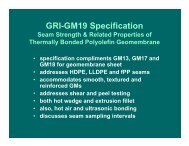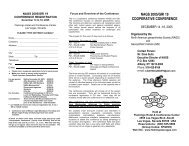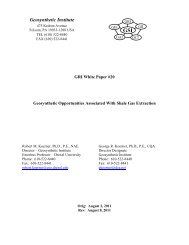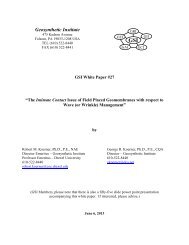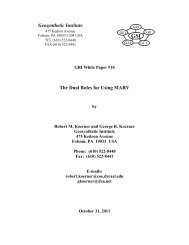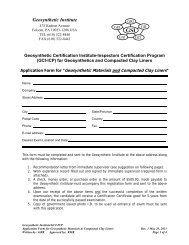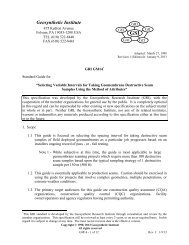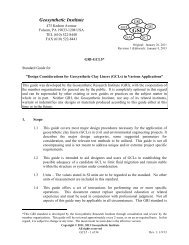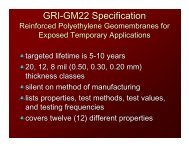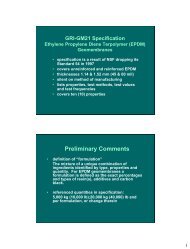December, 2012 - The Geosynthetic Institute
December, 2012 - The Geosynthetic Institute
December, 2012 - The Geosynthetic Institute
Create successful ePaper yourself
Turn your PDF publications into a flip-book with our unique Google optimized e-Paper software.
While a field inspector cannot require proper design or<br />
instruct a contractor how to build the wall, flaws can be<br />
identified for possible design modification or mitigation<br />
action. Furthermore, and at minimum, construction<br />
practices can be observed and corrected if inadequate<br />
or improper. Please contact George Koerner at<br />
gkoerner@dca.net or Jamie Koerner at<br />
jrkoerner@verizon.net for questions or additional<br />
information.<br />
<strong>The</strong> GSI Affiliated <strong>Institute</strong>s<br />
It has long been realized that the information<br />
generated within the GSI group should have a timely<br />
outlet to all countries, and in all languages. To this<br />
end, GSI has created affiliated institutes in two<br />
countries (Korea and Taiwan), and potentially others in<br />
the future. <strong>The</strong>se affiliated institutes are full members<br />
of GSI and are empowered to translate and use all<br />
available information so as to create similar institutes<br />
and activities in their respective countries.<br />
GSI-Korea was formed on February 9, 1998 as a<br />
collaborative effort between FITI Testing and Research<br />
<strong>Institute</strong> (a quasi-government organization) and INHA<br />
University (through its <strong>Geosynthetic</strong>s Research<br />
Laboratory). It is presently in the transition of being<br />
held entirely within INHA University.<br />
INHA University is located in Incheon and the<br />
geosynthetics laboratory is led by Professor Han-Yong<br />
Jeon. Dr. Jeon has 10-students working on<br />
geosynthetic-related projects and is extremely active<br />
both nationally and internationally. His active<br />
participation at conferences worldwide is very<br />
admirable. He has provided research and development<br />
in many geosynthetic subjects including geotextiles,<br />
geomembranes, geocells, additives for GCLs, recycled<br />
plastics for formulations, etc.<br />
GSI-Taiwan was formed on August 18, 2000 and is<br />
wholly contained within the National Pingtung<br />
University of Science and Technology in Nei Pu,<br />
Pingtung (southern Taiwan). It completely parallels<br />
GSI in that it has specific units for research, education,<br />
information, accreditation and certification. <strong>The</strong><br />
Director is Dr. Chiwan Wayne Hsieh who is a<br />
Professor in the Department of Civil Engineering and<br />
Dean of the R & D Office. GSI-Taiwan has an<br />
Taiwanese consortium of geogrid/geotextile<br />
manufacturers who work toward producing quality<br />
products according to the draft GRI geogrid<br />
specifications and the associated test methods. As<br />
such, GSI-Taiwan is a GAI-LAP accredited laboratory<br />
for 59 geosynthetic test methods. Dr. Hsieh has 10-<br />
students working on geosynthetic-related projects and<br />
is extremely active nationally and internationally. GSI<br />
- 10 -<br />
Taiwan has hosted three very successful internal<br />
conferences to date and has also held a much broader<br />
one, namely, GSI-Asia in Taichung, Taiwan.<br />
Items of Interest<br />
1. <strong>Geosynthetic</strong>s Restore Gulf Coast<br />
A new Duke University study, “<strong>Geosynthetic</strong>s:<br />
Coastal Management Applications in the Gulf of<br />
Mexico”<br />
(www.cggc.duke.edu/pdfs/CGGC_<strong>Geosynthetic</strong>s.p<br />
df), details how the emerging geosynthetics<br />
industry can create job benefiting nearly 200<br />
employee locations in 36 states, including more<br />
than 72 in the five gulf states and 24 in Louisiana.<br />
Increased investment in ecosystem restoration,<br />
flood prevention and erosion control is expected<br />
through the recently approved RESTORE Act,<br />
which will stimulate more local projects using<br />
geosynthetic materials.<br />
(ref. ASTM Review 09/12)<br />
2. Amount of Municipal Solid Waste Expected to<br />
Increased Significantly<br />
Worldwide, municipal solid waste is projected to<br />
increase from today’s rate of 1.3 billion lb per day<br />
to 2.2 billion lb per day by 2025, according to a<br />
recent report from the World Bank. Moreover, the<br />
annual cost to manage the waste is expected to<br />
nearly double during this period, rising from $205<br />
billion to $375 billion. In general, as a country<br />
urbanizes and its population becomes wealthier,<br />
the consumption of inorganic materials increases<br />
as the relative organic fraction decreases, the<br />
report states.<br />
(ref. Waste Business Journal and Civil<br />
Engineering, 09/12)<br />
Editor’s Note: <strong>The</strong> devastation that Hurricane<br />
Sandy created in the northeast U.S. is resulting in<br />
record amounts of waste disposal.<br />
3. World’s Biggest Construction Firms by<br />
Revenue



